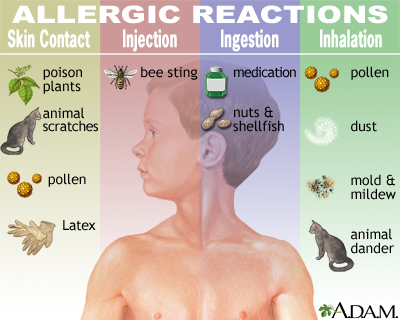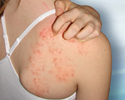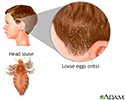Itching
Pruritus
Itching is a tingling or irritation of the skin that makes you want to scratch the area. Itching may occur all over the body or only in one location.
Causes
There are many causes of itching, including:
- Aging skin
-
Atopic dermatitis
(eczema)
Atopic dermatitis
Atopic dermatitis is a long-term (chronic) skin disorder that involves scaly and itchy rashes. It is a type of eczema. Other forms of eczema include...
 ImageRead Article Now Book Mark Article
ImageRead Article Now Book Mark Article -
Contact dermatitis
(poison ivy or poison oak)
Contact dermatitis
Contact dermatitis is a condition in which the skin becomes red, sore, or inflamed after direct contact with a substance.
 ImageRead Article Now Book Mark Article
ImageRead Article Now Book Mark Article - Contact irritants (such as soaps, chemicals, or wool)
- Dry skin
-
Hives
Hives
Hives are raised, often itchy, red bumps (welts) on the surface of the skin. They are usually an allergic reaction to food or medicine. They can al...
 ImageRead Article Now Book Mark Article
ImageRead Article Now Book Mark Article -
Insect bites and stings
Insect bites and stings
Insect bites and stings can cause an immediate skin reaction. The bite from fire ants and the sting from bees, wasps, and hornets are most often pai...
 ImageRead Article Now Book Mark Article
ImageRead Article Now Book Mark Article -
Parasites such as
pinworm
,
body lice
,
head lice
, and
pubic lice
Pinworm
Pinworms are small worms that infect the intestines.
 ImageRead Article Now Book Mark Article
ImageRead Article Now Book Mark ArticleBody lice
Body lice are tiny insects (scientific name is Pediculus humanus corporis) that are spread through close contact with other people. Two other types o...
 ImageRead Article Now Book Mark Article
ImageRead Article Now Book Mark ArticleHead lice
Head lice are tiny insects that live on the skin covering the top of your head (scalp). Head lice may also be found in eyebrows and eyelashes. Lice ...
 ImageRead Article Now Book Mark Article
ImageRead Article Now Book Mark ArticlePubic lice
Pubic lice are tiny insects that infect the pubic hair area and lay eggs there. These lice can also be found in armpit hair and eyebrows.
 ImageRead Article Now Book Mark Article
ImageRead Article Now Book Mark Article -
Pityriasis rosea
Pityriasis rosea
Pityriasis rosea is a common type of skin rash seen in young adults.
 ImageRead Article Now Book Mark Article
ImageRead Article Now Book Mark Article -
Psoriasis
Psoriasis
Psoriasis is a skin condition that causes skin redness and irritation. Most people with psoriasis have thick, red skin with flaky, silver-white patc...
 ImageRead Article Now Book Mark Article
ImageRead Article Now Book Mark Article -
Rashes
(may or may not itch)
Rashes
Rashes involve changes in the color, feeling or texture of your skin.
 ImageRead Article Now Book Mark Article
ImageRead Article Now Book Mark Article -
Seborrheic dermatitis
Seborrheic dermatitis
Seborrheic dermatitis is a common, inflammatory skin condition that causes flaky, white to yellowish scales to form on oily areas such as the scalp, ...
 ImageRead Article Now Book Mark Article
ImageRead Article Now Book Mark Article -
Sunburn
Sunburn
A sunburn is reddening of the skin that occurs after you are exposed to the sun or other ultraviolet light.
 ImageRead Article Now Book Mark Article
ImageRead Article Now Book Mark Article -
Superficial skin infections such as
folliculitis
and
impetigo
Folliculitis
Folliculitis is inflammation of one or more hair follicles. It can occur anywhere on the skin.
 ImageRead Article Now Book Mark Article
ImageRead Article Now Book Mark Article
Generalized itching may be caused by:
-
Allergic reactions
Allergic reactions
Allergic reactions are sensitivities to substances called allergens that come into contact with the skin, nose, eyes, respiratory tract, and gastroin...
 ImageRead Article Now Book Mark Article
ImageRead Article Now Book Mark Article -
Childhood infections (such as chickenpox or
measles
)
Measles
Measles is a very contagious (easily spread) illness caused by a virus.
 ImageRead Article Now Book Mark Article
ImageRead Article Now Book Mark Article -
Hepatitis
Hepatitis
Hepatitis is swelling and inflammation of the liver.
 ImageRead Article Now Book Mark Article
ImageRead Article Now Book Mark Article -
Iron deficiency anemia
Iron deficiency anemia
Anemia is a condition in which the body does not have enough healthy red blood cells. Red blood cells provide oxygen to body tissues. There are man...
 ImageRead Article Now Book Mark Article
ImageRead Article Now Book Mark Article - Kidney disease
- Liver disease with jaundice
- Pregnancy
-
Reactions to medicines and substances such as antibiotics (penicillin, sulfonamides), gold, griseofulvin, isoniazid, opiates, phenothiazines, or
vitamin A
Vitamin A
Vitamin A is a fat-soluble vitamin that is stored in the liver. There are two types of vitamin A that are found in the diet. Preformed vitamin A is...
 ImageRead Article Now Book Mark Article
ImageRead Article Now Book Mark Article
Home Care
For itching that does not go away or is severe, see your health care provider.
In the meantime, you can take steps to help deal with the itch:
- Do not scratch or rub the itchy areas. Keep fingernails short to avoid damaging the skin from scratching. Family members or friends may be able to help by calling attention to your scratching.
- Wear cool, light, loose bedclothes. Avoid wearing rough clothing, such as wool, over an itchy area.
- Take lukewarm baths using little soap and rinse thoroughly. Try a skin-soothing oatmeal or cornstarch bath.
- Apply a soothing lotion after bathing to soften and cool the skin.
- Use moisturizer on the skin, especially in the dry winter months. Dry skin is a common cause of itching.
- Apply cold compresses to an itchy area.
- Avoid prolonged exposure to excessive heat and humidity.
- Do activities that distract you from the itching during the day and make you tired enough to sleep at night.
- Try over-the-counter oral antihistamines such as diphenhydramine (Benadryl). Be aware of possible side effects such as drowsiness.
- Try over-the-counter hydrocortisone cream on itchy areas.
When to Contact a Medical Professional
Call your provider if you have itching that:
- Is severe
- Does not go away
- Cannot be easily explained
Also call if you have other, unexplained symptoms.
With most itching, you do not need to see a provider. Look for an obvious cause of itching at home.
It is sometimes easy for a parent to find the cause of a child's itching. Looking closely at the skin will help you identify any bites, stings, rashes, dry skin, or irritation.
Have the itching checked out as soon as possible if it keeps returning and does not have a clear cause, you have itching all over your body, or you have hives that keep returning. Unexplained itching may be a symptom of a disease that could be serious.
What to Expect at Your Office Visit
Your provider will examine you. You'll also be asked about the itching. Questions may include when it began, how long it has lasted, and whether you have it all the time or only at certain times. You may also be asked about medicines you take, whether you have allergies, or if you have been ill recently.
References
Garg A, Bernhard JD. Pruritus. In: Lebwohl MG, Heymann WR, Berth-Jones J, Coulson I, eds. Treatment of Skin Disease: Comprehensive Therapeutic Strategies . 4th ed. Philadelphia, PA: Elsevier Saunders; 2014:chap 198.
Raftery AT, Lim E, Ostor AJK. Pruritus. In: Raftery AT, Lim E, Ostor AJK, eds. Churchill's Pocketbook of Differential Diagnosis . 4th ed. Philadelphia, PA: Elsevier; 2014:388-390.
-
What are hives?
Animation
-
Allergic reactions - illustration
Allergic reaction can be provoked by skin contact with poison plants, chemicals and animal scratches, as well as by insect stings. Ingesting or inhaling substances like pollen, animal dander, molds and mildew, dust, nuts and shellfish, may also cause allergic reaction. Medications such as penicillin and other antibiotics are also to be taken with care, to assure an allergic reflex is not triggered.
Allergic reactions
illustration
-
Head lice - illustration
Head lice infect the scalp and hair and can be seen at the nape of the neck and over the ears. Head lice spread easily and quickly but do not carry disease as other lice do.
Head lice
illustration
-
Skin layers - illustration
The skin is the largest organ of the body. The skin and its derivatives (hair, nails, sweat and oil glands) make up the integumentary system. One of the main functions of the skin is protection. It protects the body from external factors such as bacteria, chemicals, and temperature. The skin contains secretions that can kill bacteria and the pigment melanin provides a chemical pigment defense against ultraviolet light that can damage skin cells. Another important function of the skin is body temperature regulation. When the skin is exposed to a cold temperature, the blood vessels in the dermis constrict. This allows the blood which is warm, to bypass the skin. The skin then becomes the temperature of the cold it is exposed to. Body heat is conserved since the blood vessels are not diverting heat to the skin anymore. Among its many functions the skin is an incredible organ always protecting the body from external agents.
Skin layers
illustration
-
Allergic reactions - illustration
Allergic reaction can be provoked by skin contact with poison plants, chemicals and animal scratches, as well as by insect stings. Ingesting or inhaling substances like pollen, animal dander, molds and mildew, dust, nuts and shellfish, may also cause allergic reaction. Medications such as penicillin and other antibiotics are also to be taken with care, to assure an allergic reflex is not triggered.
Allergic reactions
illustration
-
Head lice - illustration
Head lice infect the scalp and hair and can be seen at the nape of the neck and over the ears. Head lice spread easily and quickly but do not carry disease as other lice do.
Head lice
illustration
-
Skin layers - illustration
The skin is the largest organ of the body. The skin and its derivatives (hair, nails, sweat and oil glands) make up the integumentary system. One of the main functions of the skin is protection. It protects the body from external factors such as bacteria, chemicals, and temperature. The skin contains secretions that can kill bacteria and the pigment melanin provides a chemical pigment defense against ultraviolet light that can damage skin cells. Another important function of the skin is body temperature regulation. When the skin is exposed to a cold temperature, the blood vessels in the dermis constrict. This allows the blood which is warm, to bypass the skin. The skin then becomes the temperature of the cold it is exposed to. Body heat is conserved since the blood vessels are not diverting heat to the skin anymore. Among its many functions the skin is an incredible organ always protecting the body from external agents.
Skin layers
illustration
Review Date: 7/13/2016
Reviewed By: Linda J. Vorvick, MD, Medical Director and Director of Didactic Curriculum, MEDEX Northwest Division of Physician Assistant Studies, Department of Family Medicine, UW Medicine, School of Medicine, University of Washington, Seattle, WA. Also reviewed by David Zieve, MD, MHA, Isla Ogilvie, PhD, and the A.D.A.M. Editorial team.






